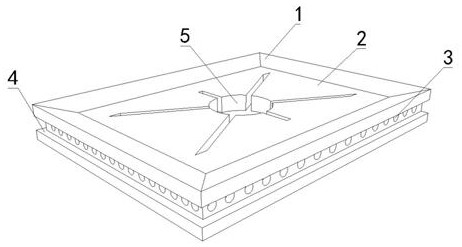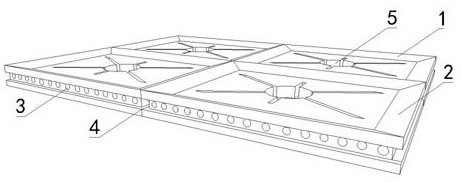A biogas residue bio-brick for vertical greening of building exterior walls and greening method
A technology for building exterior walls and vertical greening, applied in the fields of urban forestry science and human settlement environment science, can solve the problems of limited growth range of climbing plants, long greening period, limited greening scope, etc., and achieves heat insulation, energy saving, noise, and low manufacturing costs. , the effect of convenient transportation
- Summary
- Abstract
- Description
- Claims
- Application Information
AI Technical Summary
Problems solved by technology
Method used
Image
Examples
Embodiment 1
[0017] Embodiment 1: as Figure 1-3 As shown, a biogas residue bio-brick used for vertical greening of building exterior walls includes a sintered brick body 1 and a bio-brick body 2 embedded in it, the surface of the sintered brick body 1 is sunken inward to form a picture frame structure, The bio-brick body 2 is snapped into the frame-shaped structure, and the periphery of the sintered brick body 1 is sunken inwards to form a flow channel 4. There is a flow hole 3 on the intersecting surface of the flow channel 4 and the sintered block body 1, and the flow hole 3 is connected to the bio-brick. Body 2; planting holes 5 are opened on the surface of the biological brick body 2.
[0018] The sintered brick body 1 is made of clay, shale, coal gangue or fly ash as raw materials, formed and fired at high temperature, and its shape can be rectangular, square or rhombus, which is convenient for regular splicing. During production, the sintered brick body 1 and the biological brick b...
Embodiment 2
[0019] Embodiment 2: Wherein the biological brick body 2 is made of biogas residue, and is pressed with the configuration of fine sand, superabsorbent resin, and starch adhesive to make a brick body suitable for dwarf philodendron, and the composition ratio is: biogas residue: 60-70 %; fine sand: 15-20%; super absorbent resin: 1-2%; starch binder: 9-13%.
[0020] Biogas residue is the waste solid material biogas residue left after the fermentation of crops or manure organic matter. In addition to being rich in nitrogen, phosphorus, potassium and other elements to meet the basic growth needs of plants, there are also boron, copper, and iron that play an important role in plant growth. , manganese, zinc and other trace elements, especially the high content of humic acid, is very suitable for plant substrates; super absorbent resin is a new type of polymer material, which can absorb hundreds to thousands of times its own weight Moisture, non-toxic, harmless, non-polluting; super ...
Embodiment 3
[0021] Embodiment 3: In this embodiment, Ophiopogon japonicus is used as a greening plant for vertical greening, and Ophiopogon japonicus is used as a vertical greening plant for buildings. It is evergreen in all seasons, has strong resistance to shade, and is resistant to drought. It can also be planted in northern regions where the climate is relatively dry. It has low water requirements, strong nature, high survival rate, strong adaptability to soil, and does not require special management.
[0022] The sintered bricks 1 are regularly spliced and paved on the surface of the building's outer wall, and the flow channels 4 of each sintered brick 1 are aligned and connected to form a water diversion channel that runs through from top to bottom, and the dwarf Ophiopogon japonicus is planted on the surface of the biological brick 2 Planting in the planting hole 5, the irrigation water enters the water hole 3 along the water diversion channel and then waters the bio-brick body 2....
PUM
 Login to View More
Login to View More Abstract
Description
Claims
Application Information
 Login to View More
Login to View More - R&D
- Intellectual Property
- Life Sciences
- Materials
- Tech Scout
- Unparalleled Data Quality
- Higher Quality Content
- 60% Fewer Hallucinations
Browse by: Latest US Patents, China's latest patents, Technical Efficacy Thesaurus, Application Domain, Technology Topic, Popular Technical Reports.
© 2025 PatSnap. All rights reserved.Legal|Privacy policy|Modern Slavery Act Transparency Statement|Sitemap|About US| Contact US: help@patsnap.com



